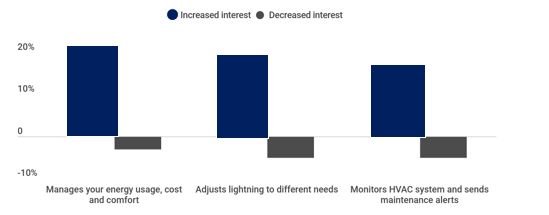Curbing the Energy Crunch
13 June 2022
Share with a Friend
All fields required where indicated (*)Energy management is already a key component of the smart home and the current crisis is encouraging more people to explore options for cutting energy consumption (see graph). By favoring cleaner energy, providing insights into energy usage, and reducing energy consumption, smart home solutions can help to cut energy bills and emissions. Moreover, these energy solutions will lay a basis for further smart home adoption. Once people trust their homes to manage their energy, they are likely to let it look after other areas too.
Consumer Interest in Energy Solutions Continues to Grow

Source: Parks Associates, data from September 2020 until October 2021.
Laying out a smart home energy infrastructure
Our homes can help significantly in reducing our energy consumption. A first step is to introduce the right infrastructure by replacing electric heating systems and water heaters with air source heat pumps and heat pump water heaters. Other quick wins are the addition of insulation, energy efficient lighting and even smart window solutions. The latter control incoming light and change appearance based on the amount of sunlight, heat, cold and more.
Smart meters and thermostats are a core part of the smart energy installation. They provide residents with insights into energy consumption, enabling them to act in ways that save energy and lower the electricity bill. Parks Associates research even found that smart thermostat owners in the US saved $49 per month on average as a result of these devices.
The home as a power plant
In addition to saving energy, our homes can also generate electricity. A growing number have solar panels to supplement their electricity needs and even sell their energy back to the grid. Unfortunately, the growth of solar in several regions is hampered by limitations in the electricity network. Nevertheless, power companies are working hard to upgrade their networks for solar power backed by home batteries and even electric cars; residents will be able to store their excess production.
Tesla, for instance, is hoping to turn some Texas homes into “virtual power plants” after tests showed its home batteries can be quickly tapped to reduce stress on the state grid. Moreover, smart meters can also take the energy availability into account. Google’s Nest, for example, allows homes to automatically adjust their heating and cooling to favor cleaner energy.
Catalyst for smart home adoption
Whereas many smart home solutions – as described in a previous blog – might be characterized as gadgets, smart energy solutions can truly solve a consumer problem. Moreover, once people have installed a smart energy system, it is a small step to add other smart home functionalities, such as a security system, setting the stage for further adoption and the development of new services described in our earlier blogs.
Important Disclosure
Sign-up for our ETF newsletter